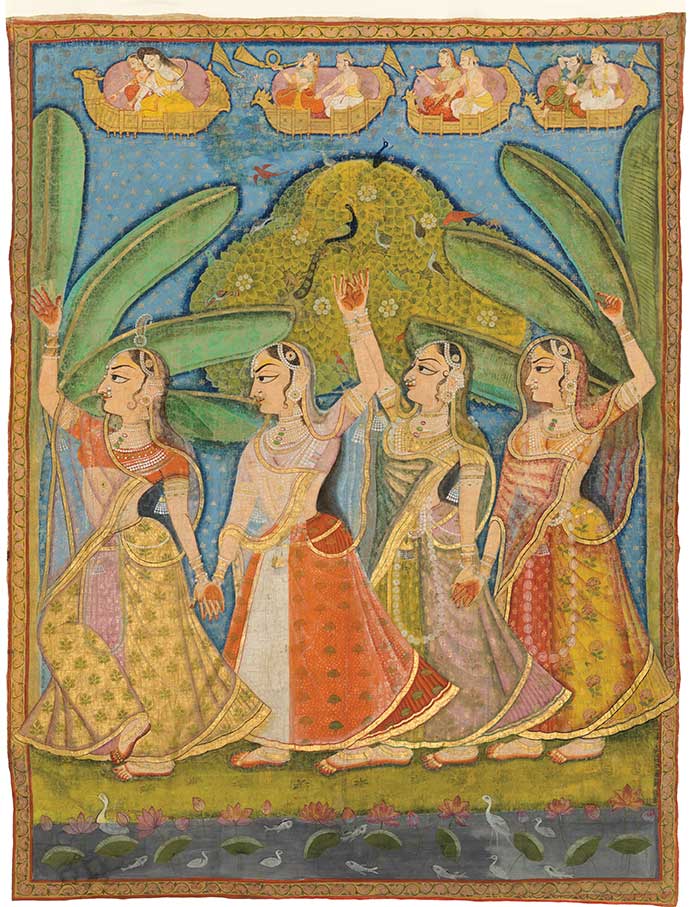An exhibition highlighting monumental paintings called pichvais is currently on show in Washington, DC. These paintings play a central role in the religious practices of the Hindu Pushtimarg (The Path of Grace) community, who engage with the divine by caring for and delighting the child-God Krishna. Collectively, the artworks convey the philosophical and emotional resonance of the Pushtimarg tradition as well as the creative ingenuity of its artists.
For the first time since the 1970s, 14 newly conserved pichvais from the National Museum of Asian Art’s collection are on view together. Dating from the 18th to the 20th century, most were painted in Nathdwara, Rajasthan, the centre of the Pushtimarg community. Alongside the pichvais, the exhibition features court paintings and mixed media works on paper that further illustrate the Pushtimarg tradition and Krishna’s personality.
Pichvais, deriving from the Hindi word for ‘behind’, are traditionally displayed behind icons of Krishna in three-dimensional displays, along with music, food, and flowers. Painted with vivid pigments and gold on cotton, the paintings average 245 x 245 cm in size. The scenes depicted on pichvais evoke momentous events from Krishna’s life on earth in a cowherders’ village. For Pushtimarg devotees, these paintings act as a bridge between ordinary life and the transcendent. The Pushtimarg tradition was established in the early 16th century by the sage Vallabha (1479-1531). The Vedic philosopher who emphasised the teachings and the of the Bhagavad Purana. This epic relates how Krishna was born into the Yadava clan and escaped death as a child and was smuggled across the Yamuna River to Gokula (Vraja), where he was raised by the leader of the cowherders, Nanda, and his wife Yashoda. In this tradition, devotees gain spiritual insight and joy by taking care of and delighting the Child-God Krishna, the supreme deity and source of everything.
Krishna as the Child-God
Krishna is one of the most widely revered and popular divinities in Hinduism, worshipped as the eighth incarnation of the Hindu god Vishnu. The deity manifests in many ways, but for the Pushtimarg community in India, the focus is on his most emotionally accessible forms – as a baby and a child. The paintings in this exhibition depict Krishna playing his flute, dancing, causing mischief, and heroically protecting his community. The child Krishna was also loved for his mischievous behaviour, and passages in the Bhagavad Purana describe the many miracles he performed, as well as detailing his slaying of demons. As a youthful cowherd, he also became a renowned lover with the sound of his flute prompting the gopis (cowgirls) to leave their homes to dance ecstatically with him in the moonlight.
Pushtimarg bhakti (devotion) is a spontaneous, selfless, and motiveless pure love for God that can be expressed only through devotion and service to God, or seva (selfless service), a practice in which his idols or representations are served and entertained with food, drink, music and art, whilst recreating his daily routine as a youth. A devotee will only find this true love after realising the true nature of God. This devotion goes beyond caste, creed, colour, sex or age, as the only criteria is to earn is ‘God’s Grace’. The Pushtimarg service to God does not require a devotee to give up their normal family life, as all worldly desires are diverted towards God through service, which means personal desires or wishes do not need to be suppressed. If the devotee can gain this state of liberation, it is believed they will merge into God’s blissful form.
Chase F Robinson, the museum’s director, explains the direction behind the exhibition, ‘As the National Museum of Asian Art begins its second century, we are committed to collaborating with communities beyond our four walls. Delighting Krishna contextualises our exceptional collection of pichvais through not only scientific and historic perspectives but also the personal perspectives of people who encounter works like these in their everyday lives’.
A collaborative approach to curation also distinguishes the exhibition from other Indian exhibitions at the Sackler Gallery, as it features material analyses from a three-year campaign of restoring the pichvais and analysing their pigments and cotton supports. Visitors can also encounter the artworks from multiple angles through insights from devotees, scholars of religion and art history, conservators and a conservation scientist. The exhibition also includes works from the Kenneth X and Joyce Robbins Collection and the museum’s South Asian and Himalayan collection, which holds over 1,200 objects. It is part of the five-year Arts of Devotion initiative at the National Museum of Asian Art, which aims to further civil discourse around religion through the museum’s collections of Hindu and Buddhist art and arts of the Islamic world.
From 15 March to 24 August, 2025, National Museum of Asian Art, Arthur M Sackler Gallery, Washington DC, asia.edu







